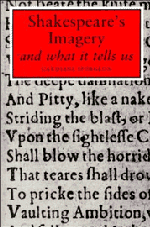Book contents
- Frontmatter
- ACKNOWLEDGEMENTS
- PREFACE
- Contents
- ILLUSTRATIONS
- Part I THE REVELATION OF THE MAN
- I The Aim and Method explained
- II Shakespeare's Imagery compared with that of Marlowe and Bacon
- III Imagery of Shakespeare and other Dramatists compared
- IV The Subject-matter of Shakespeare's Images
- V Shakespeare's Senses
- VI Shakespeare's Tastes and Interests
- VII Shakespeare's Tastes and Interests (continued)
- VIII Evidence in the Images of Shakespeare's Thought
- IX Evidence in the Images of Shakespeare's Thought (continued)
- X Association of Ideas
- XI Shakespeare the Man
- Part II THE FUNCTION OF THE IMAGERY AS BACKGROUND AND UNDERTONE IN SHAKESPEARE'S ART
- APPENDICES
- INDEX
- CHARTS
IX - Evidence in the Images of Shakespeare's Thought (continued)
Published online by Cambridge University Press: 20 February 2010
- Frontmatter
- ACKNOWLEDGEMENTS
- PREFACE
- Contents
- ILLUSTRATIONS
- Part I THE REVELATION OF THE MAN
- I The Aim and Method explained
- II Shakespeare's Imagery compared with that of Marlowe and Bacon
- III Imagery of Shakespeare and other Dramatists compared
- IV The Subject-matter of Shakespeare's Images
- V Shakespeare's Senses
- VI Shakespeare's Tastes and Interests
- VII Shakespeare's Tastes and Interests (continued)
- VIII Evidence in the Images of Shakespeare's Thought
- IX Evidence in the Images of Shakespeare's Thought (continued)
- X Association of Ideas
- XI Shakespeare the Man
- Part II THE FUNCTION OF THE IMAGERY AS BACKGROUND AND UNDERTONE IN SHAKESPEARE'S ART
- APPENDICES
- INDEX
- CHARTS
Summary
Shakespeare's views about goodness are less easy to disentangle from his images than is his general attitude towards evil. That is, he has fewer pictures of goodness and these nearly all show it in its relation to evil.
One thing is clear, from his plays and images alike—that he is ever conscious of the strange mixture of both good and evil in our life and being, of the necessity for the presence of both to make up the fabric as we know it, for
The web of our life is of a mingled yarn, good and ill together.
Not only that, but the one actually produces or gives birth to the other, and too much goodness may even make it easier for evil to flourish and escape punishment, as when York, the ‘loyal father of a treacherous son’, is pictured as a pure and silver stream, from whence Aumerle
through muddy passages
Hath held his current and defiled himself:
Bolingbroke tells York,
Thy overflow of good converts to bad,
And thy abundant goodness shall excuse
This deadly blot in thy digressing son:
to which York answers bitterly,
So shall my virtue be his vice's bawd.
On the other hand it is clear that evil continually calls out good, affliction produces patience and other virtues, war and danger are the trumpet calls to courage and endurance, as Harry the king perceives so clearly when, before Agincourt, he makes the rounds of his camp and reflects on the ‘ soul of goodness in things evil’.
- Type
- Chapter
- Information
- Shakespeare's Imagery and What it Tells Us , pp. 168 - 185Publisher: Cambridge University PressPrint publication year: 1935



